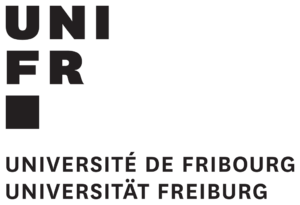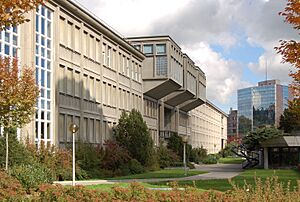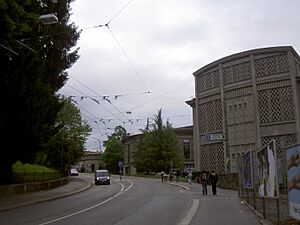University of Fribourg facts for kids
|
Université de Fribourg
Universität Freiburg |
|
 |
|
| Latin: Universitas Friburgensis | |
| Motto | Scientia et Sapientia ("Knowledge and Wisdom") |
|---|---|
| Type | Public |
| Established | 1582/1763, 1889 |
| Rector | Katharina Fromm |
|
Administrative staff
|
academic 1'150, admin 750 |
| Students | 10,000 |
| Location |
,
,
46°48′23″N 7°09′06″E / 46.80625°N 7.15174°E |
| Campus | University town |
| Affiliations | BeNeFri; Compostela Group of Universities |
The University of Fribourg is a public university located in Fribourg, Switzerland. It is special because it's the only university in Switzerland where you can study in both French and German. About 10,000 students attend this university.
The university's story began in 1580. A famous Jesuit named Peter Canisius started a school called Collège Saint-Michel in Fribourg. Later, in 1763, a law academy was created. These early schools helped form what is now the University of Fribourg, which officially opened in 1889.
Contents
History of the University
The University of Fribourg has a long and interesting history. It started with the Jesuit College St. Michel, founded by Peter Canisius in 1580. This college was on Belze Hill. In 1763, a special school for law was opened.
In 1834, a public library was created using books from Catholic monasteries. The College St. Michel closed for a while after the Jesuits left Fribourg.
Later, in 1886, Georges Python, a local leader, helped raise money to create the university. He even got 2.5 million Swiss Francs from the local government! The cantonal library became part of the university, and the law school became the Faculty of Law.
In 1939, the university moved to a new campus called Misericorde. During World War II, the university helped educate Polish prisoners of war by offering them various courses. The Perolles campus was built later on the site of an old factory.
Even though many classes were once taught in Latin, Fribourg is now famous for being the only university in the world that teaches in both French and German. About 45% of classes are in French and 55% in German.
New Developments and Features
| University rankings | |
|---|---|
| Global – Overall | |
| ARWU World | 501–600 (2023) |
| QS World | =563 (2024) |
| THE World | 401–500 (2024) |
| USNWR Global | =537 (2023) |
In 2005, the university opened its Perolles 2 campus. This is where the Faculty of Economics and Social Science moved.
The university has one of the largest collections of ancient Biblical items in the world. It also has a special center called FriMat, which focuses on tiny materials called nanotechnology.
Fribourg is part of the BeNeFri association with the Universities of Berne and Neuchâtel. This means students can take classes at any of these universities and still get credit at their home school. The university now follows the Bologna process, which helps make degrees similar across Europe.
In 2009, the university started a new law program called the Master of Laws in Cross-Cultural Business Practice (MLCBP). This program is taught entirely in English.
University Campuses
The University of Fribourg doesn't have one main campus. Its buildings are spread out across the city. Here are some of the main locations:
- Misericorde: This is where humanities subjects are taught, and it houses the main administration offices.
- Perolles: This campus is for science studies.
- Perolles 2: This is where students study economics and social sciences.
- Regina Mundi: This building is for psychology studies.
- BCU centrale: This is the main library for the university and the canton.
- Pierre Aeby: This department focuses on classical languages and literature.
- Bonnesfontaines: This campus is for education studies.
- Stade St. Leonard: This is the university's sports stadium.
Study Areas (Faculties)
The University of Fribourg has five main study areas, called faculties:
- The Faculty of Humanities is the biggest, with about 4,600 students. Here, students learn about philosophy, history, languages, literature, education, psychology, and social sciences.
- The Faculty of Law has about 1,900 students. They study national and international law, and can do so in both French and German.
- The Faculty of Theology is the largest and most international theology faculty in Switzerland. It's one of the few state universities in Switzerland with a Catholic Theology faculty.
- The Faculty of Management, Economics and Social Sciences has about 1,400 students. They can choose from programs in business management, economics, computer science, and media and communication.
- The Faculty of Science and Medicine was created in 1896. It has seven departments, including biology, chemistry, computer science, mathematics, medicine, and physics. They offer studies in many fields like biochemistry, neuroscience, and environmental sciences. The Adolphe Merkle Institute (AMI) is a research center here that studies tiny materials called nanomaterials.
University Traditions
- Dies Academicus: This is a special day in November when no regular classes are held. It starts with a church service, and then university members walk in a formal procession to the Great Hall. The university leader (rector) gives a speech, and special guests are honored. Students from old clubs wear traditional outfits, sometimes with swords.
- Student Clubs (Corporations): These are like traditional student clubs, similar to those in Germany and Austria. Members meet regularly to socialize, sing, and enjoy time together. They are often organized by language. Many of Fribourg's student clubs belong to the Swiss Student Association, which used to be Catholic. Joining these clubs can sometimes help with future careers.
- The Day of Welcomes (Jour D’Accueil): This is like an orientation day for new students. They are welcomed by the university rector and the mayor of Fribourg. Afterwards, they share a meal with their professors and other students.
- Fribourg Sunday: Every year, the Catholic Church in Switzerland collects money during masses. This money is mainly used to give scholarships to priests from other countries who want to study at the Faculty of Theology.
University Symbols
The university's official seal shows a cross and a bishop's ring. These represent the university's Catholic background. They are placed on a black and white shield, which are the colors of the Fribourg region. The university's logo is a blue letter "F" that looks like triangles, reminding people of the Alps and the university's main building. The university's name is written in Latin.
Famous People from the University
Many notable people have studied or taught at the University of Fribourg.
Writers and Academics
- Patrick Aebischer: Former president of a famous technical university in Switzerland.
- Mary Daly: A well-known feminist theologian.
- Lionel Groulx: A priest and historian from Quebec.
- Winfried Sebald: A German writer.
- Peter Trudgill: A British expert in how language changes in different places.
- Chaim Weizmann: The first President of Israel.
Clergy (Religious Leaders)
- Basil Hume: A former Archbishop of Westminster.
- Christoph Schönborn: The Archbishop of Vienna.
- Angelo Scola: The Patriarch of Venice.
Politics
- Juan Carlos I: The former King of Spain.
- Corina Casanova: A former Federal Chancellor of Switzerland.
- Joseph Deiss: A former Federal Chancellor of Switzerland and President of the United Nations General Assembly.
- Ignacy Mościcki: A former President of Poland.
- Simonetta Sommaruga: A member of the Swiss Federal Council and former President of the Swiss Confederation.
Business and Economics
- Klaus Martin Schwab: The founder and leader of the World Economic Forum, a very important global meeting.
Sports
- Gianni Infantino: The current president of FIFA, the world's football governing body.
Judiciary (Law)
- Antonin Scalia: A former Justice of the Supreme Court of the United States.
Gallery
See also
 In Spanish: Universidad de Friburgo (Suiza) para niños
In Spanish: Universidad de Friburgo (Suiza) para niños
- List of largest universities by enrollment in Switzerland
- List of modern universities in Europe (1801–1945)
- List of universities in Switzerland
- Education in Switzerland
- Bible and Orient Museum
- Science and technology in Switzerland
- List of colleges and universities by country
- List of colleges and universities






